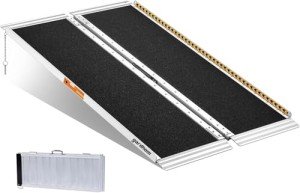
Ramps
Add a review FollowOverview
-
Founded Date July 8, 1921
-
Sectors Overseas
-
Posted Jobs 0
-
Viewed 4
Company Description
How To Research Ramps For Wheelchair Online
Understanding Ramps for Wheelchairs: A Comprehensive Guide
Wheelchair Ramps UK availability is important for promoting self-reliance and mobility for people with specials needs or mobility obstacles. Ramps play a vital role in making sure that people who utilize wheelchairs can navigate their environments safely and without barriers. In this article, we will check out the significance of wheelchair ramps, the various types available, guidelines for installation, and regularly asked questions about wheelchair ramps.

The Importance of Ramps for Wheelchairs
Ramps are crucial setups designed to facilitate smooth transitions between various elevation levels. They not only enhance mobility for wheelchair users but also enhance ease of access for individuals utilizing other mobility aids, such as walkers or crutches. Here are some essential factors why ramps are essential:
- Improved Accessibility: Ramps supply Wheelchair Ramp Portable users the capability to access structures, homes, and public areas that may otherwise be off-limits due to stairs or unequal ground.
- Safety: Ramps lower the danger of falls and accidents related to browsing stairs, particularly for people who might deal with balance and mobility.
- Compliance with Regulations: Many countries have specific guidelines and regulations aimed at ensuring availability for individuals with disabilities. Ramps assist meet these legal requirements.
- Self-reliance: By providing a safe means of access, ramps enhance the self-reliance of wheelchair users, permitting them to browse their environments without support.
Kinds Of Wheelchair Ramps
Ramps are available in various styles and products to fit a vast array of environments and needs. Below is an overview of the most typical types of wheelchair ramps:
| Ramp Type | Description | Perfect Use |
|---|---|---|
| Irreversible Ramps | Built from durable materials like concrete or wood and are meant for long-lasting usage. | Residential homes, public buildings |
| Portable Ramps | Lightweight and created for easy transportation and setup. Normally made from aluminum or fiberglass. | Temporary access at occasions, homes, or take a trip |
| Folding Ramps | Portable ramps that can be folded for simple storage and transportation; they can be found in adjustable lengths. | On-the-go availability |
| Limit Ramps | Short ramps created to bridge the space in between a door and a flooring; useful for small steps. | Entry thresholds in homes or companies |
| Car Ramps | Particularly designed for loading wheelchairs into vehicles; they can be foldable or expandable. | Vans, SUVs, and cars |
| Modular Ramps | Made of interlocking components that can be customized for various heights and lengths; ideal for temporary or long-term access solutions. | Neighborhood centers, schools |
Factors to Consider When Choosing a Ramp
When selecting a ramp, it’s important to evaluate numerous aspects to make sure safety and usability:
- Height: The height the ramp needs to cover.
- Length and Angle: Ramps need to have a gentle slope for ideal ease of usage. The Americans with Disabilities Act (ADA) recommends a 1:12 slope ratio (1 inch of height for each 12 inches of length).
- Materials: The product impacts weight capacity, sturdiness, and upkeep.
- Weight Capacity: Always check the weight limitation of the ramp to guarantee it can securely accommodate the user.
- Place: Indoor vs. outdoor use may affect the type of ramp selected.
Installation Guidelines
Establishing a wheelchair ramp needs cautious preparation and adherence to guidelines laid out by the ADA and regional guidelines. Here are some vital steps to keep in mind:
- Site Assessment: Evaluate the installation site for area, slope, and surface area conditions. Make sure that the location is totally free from barriers.
- Design Compliance: Follow regional and state building codes and ADA specs for ramp dimensions, including width, slope, and landings.
- Landings: Ensure that landings at both the top and bottom of the Handicap Ramp are flat and sufficiently large to enable safe turning or steering.
- Maintenance: Regularly check the ramp for any indications of wear or damage. Ensure that surface products offer appropriate traction in different weather condition conditions.
Frequently Asked Questions About Wheelchair Ramps
Q1: Are wheelchair ramps needed by law?
Yes, numerous jurisdictions have laws needing specific buildings and public areas to be accessible to people with disabilities, including the installation of wheelchair ramps.
Q2: How high can a wheelchair ramp be?
According to the ADA guidelines, the maximum slope allowed is 1:12 for wheelchairs, which equates to a one-inch increase for every 12 inches of ramp length.
Q3: Can a wheelchair ramp be set up on stairs?
Yes, wheelchair ramps can be created to accommodate stairs, however it might be necessary to consider the security of both the user and the structure.
Q4: What products are best for outdoor wheelchair ramps?
For outside ramps, materials like aluminum and dealt with wood are commonly preferred due to their toughness and capability to withstand weather components.
Q5: How much does a wheelchair ramp expense?
Expenses can differ considerably based on the Metal Ramp For Wheelchair type, materials utilized, and customized features. Portable ramps might start at around ₤ 100, while permanent ramps can cost several thousand dollars depending on style and setup.
Ramps are an invaluable possession for promoting ease of access for individuals utilizing wheelchairs and other mobility aids. Understanding your choices, recognizing the importance of correct installation, and sticking to safety guidelines are all vital steps to enhance mobility and independence. Whether a portable solution is required for periodic usage or an irreversible ramp is required for frequent access, picking the ideal ramp can make all the difference. With thoughtful preparation and execution, ramps can transform the method individuals browse their environments, making the world a more inclusive place for everybody.

